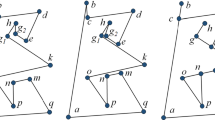Abstract
A consistent modelling scheme for digital images is presented, with the grey-level raster image as input and the list-oriented polygonal image as output. The output information consists of two parts: The metric of the polygonal object, represented by coordinates of marked positions, and the global topology, which takes the form of a two-dimensional topologic order. The central problem, which has to be solved, is to select a digital polygon, approximating a digital arc such that the essential feature of the arc is represented at a predefined precision level. The proposed algorithm uses simple incremental calculations of INTEGER quantities to solve the problem.
Zusammenfassung
Es wird ein konsistentes Modellierungsschema für digitale Bilder vorgestellt, das als Input das Grauwertbild und als Output das listenorientierte polygonale Objekt enthält. Die ausgegebene Information besteht aus zwei Teilen: Die Metrik des polygonalen Objektes wird durch Koordinaten markanter Positionen dargestellt und die globale Topologie erscheint in Form einer zweidimensionalen topologischen Ordnung. Das zentrale Problem, das zu lösen ist, besteht darin, ein digitales Polygon auszuwählen, das einen digitalen Bogen in solcher Weise approximiert, daß die wesentliche Gestalt des Bogens auf einem vorgegebenen Präzisionsniveau beschrieben wird. Der vorgeschlagene Algorithmus benutzt einfache inkrementelle Berechnungen von INTEGER-Größen, um das Problem zu lösen.
Similar content being viewed by others
References
Eichhorn, N., Kiesewetter, H.: Grundsätze zur Detektion von Konturen. Bild und Ton41, 69–74 (1988).
Kiesewetter, H.: Two-dimensional topologic orders and picture processing. CAIP'87, pp. 187–195. Berlin: Akademie-Verlag 1987.
Rosenfeld, A., Kak, A. C.: Digital Picture Processing. New York: Academic Press 1982.
Pavlidis, T.: Structural Pattern Recognition. New York: Springer-Verlag 1977.
Pavlidis, T.: Curve fitting with conic splines. ACM Transactions on Graphics2, 1–31 (1983).
Tomek, I.: Two algorithms for piecewise linear continuous approximation of functions of one variable. IEEE Trans. Computers23/4, 445–448 (1974).
Sklansky, J., Kibler, D. P.: A theory of non-uniformly digitizing binary pictures. IEEE Trans. SMC6/9, 637–647 (1976).
Oliviero, A., Scarpetta, G.: A new approach to contour coding. Computer Graphics and Image Processing15, 87–92 (1981).
Wall, K., Danielsson, P. E.: A fast sequential method for polygonal approximation of digitized curves. Computer Vision, Graphics, and Image Processing28, 220–227 (1984).
Wall, K.: Curve fitting based on polygonal approximation. Proc. 8th Int. Conf. Pattern Recognition2, 1273–1275 (1986).
Sklansky, J., Gonzales, V.: Fast polygonal approximation of digitized curves. Pattern Recognition12, 327–331 (1980).
Author information
Authors and Affiliations
Rights and permissions
About this article
Cite this article
Eichhorn, N., Kiesewetter, H. INTEGER analysis of two-dimensional polygonal objects. Computing 42, 1–16 (1989). https://doi.org/10.1007/BF02243139
Received:
Issue Date:
DOI: https://doi.org/10.1007/BF02243139




